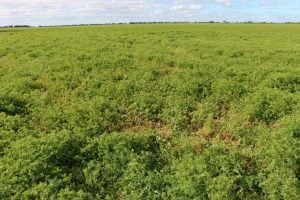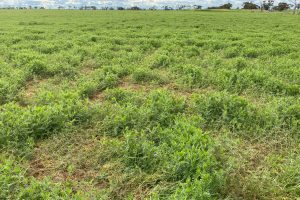Sclerotinia white mould (SWM) is a damaging disease that can infect many pulse crops including lentil, chickpea, faba bean, vetch, field pea and lupin. It can also affect canola, pasture legumes and many weeds. This disease poses its greatest risk during seasons with prolonged damp conditions.
Sclerotinia white mould has been observed more frequently since 2019 in Victoria throughout the Wimmera and Mallee districts.
Sclerotinia white mould is a sporadic disease that only develops under specific conditions. It requires wetter seasons to develop to damaging levels. Being a sporadic disease there is currently limited information on effective in crop control options or expected yield losses that it causes. A new co-investment between the Grains Research Development Corporation (GRDC) and NSW Department of Primary Industries (Lead Agency), Agriculture Victoria, South Australian Research and Development Corporation, University of Queensland and Marcroft Grains Pathology will investigate the epidemiology and control methods for SWM.
What to look for
A small number of dead plants scattered throughout a crop are the first signs of SWM. Affected plants often wilt then rapidly die, often without turning yellow (Figures 1 and 2).
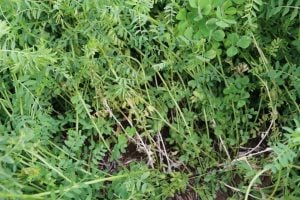
Figure 1. Lentil plants which have died due to sclerotinia white mould. White fungal (mycelial) growth can be observed on the lower stems (Photo, Joshua Fanning Agriculture Victoria).
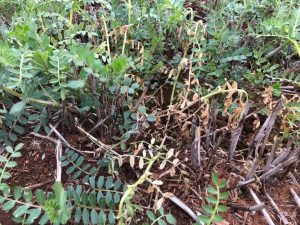
Figure 2. Chickpea plants dying from sclerotinia white mould. Photo provided by Matt Whitney (Dodgshun Medlin)
When conditions favour further disease development, large patches of dying plants can be observed within an affected crop (Figure 3a and b).
- Figure 3a. Sclerotinia infection spreading throughout a Lentil paddock
- Figure 3b. Sclerotinia infection spreading through a Vetch paddock (Photo, Joshua Fanning Agriculture Victoria).
The stems of plants within affected areas develop a slimy soft rot from which droplets of a brown liquid may exude. Infected tissues then dry out and may become covered with a web of white mycelium of the fungus (Figure 4). Just below ground level, small black fungal bodies called sclerotia (which are irregular in size and shape) can sometimes be seen mingled with white cottony fungal mycelium (Figure 5).
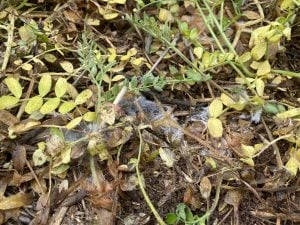
Figure 4. White mycelial growth on stems, typical with sclerotinia white mould (Photo, Joshua Fanning Agriculture Victoria).
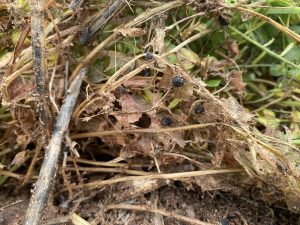
Figure 5. Black sclerotia found formed on the stems of vetch plants (Photo, Joshua Fanning Agriculture Victoria).
Disease Cycle
Sclerotinia white mould, caused by Sclerotinia sclerotiorum, S. minor and S. trifoliorum, is usually established from sclerotia (survival bodies of the fungus) present in the soil or introduced with contaminated seed. Outbreaks are more common when very wet conditions occur in late June and early July.
The sclerotia germinate in moist soil and either directly infect roots via mycelium or produce air-borne spores which infect the above ground parts of the plant. Once established, the fungus rapidly moves to adjacent healthier tissue. Within a few days of infection, plants start to wither then die.
Sclerotia (survival bodies) formed on infected plants enable the fungus to survive several years in the soil. Individual seeds can be contaminated with the fungus and/or sclerotia may be present in the seed sample. Sclerotia can remain viable in the soil for up to eight years.
Soil-borne sclerotia are the most important infection source for establishing disease in following crops and seasons. Seeds infected with Sclerotinia can be the cause of disease establishment in otherwise Sclerotinia-free areas.
Current controls in Victoria
Currently, there are limited fungicides registered for the management of sclerotinia white mould in pulse crops. The canopy closure sprays of carbendazim to manage Botrytis grey mould Grey Mould (BGM) in lentils will not manage SWM and is an illegal off label use of a restricted use chemical.
Grazing, where applicable (i.e. vetch), may open the canopy and allow better coverage of the fungicide and therefore, increase fungicide efficacy. Consider cutting hay earlier to prevent a decrease in hay quality.
Fungicides
The following tables summarise products that may be considered for use to control SWM. Use of some fungicides listed in the tables would be off label, meaning use for the control of sclerotinia is not specified on the product label. Off label use of a product to control SWM is regulated under the Victorian Agricultural and Veterinary Chemicals (Control of Use) Act 1992, for example it would be illegal to use a product at a higher rate or more frequently than stated for that use on the label, as well as using a chemical contrary to a prohibitive (DO NOT) statement.
Off label use of any chemical carries with it increased risks that chemical users must manage. The risks include issues like efficacy, residues in harvested produce or the environment, and occupational health and safety.
Recent changes to the off-label use of chemical in low-risk situations has increased the options available to growers. In the past restricted use chemicals e.g. Schedule 7 Dangerous Poisons had to be used in strict accordance with the label, however, now they can be used off label in the following low risk situations:
- the use is to control a pest that is different from the pest stated on the approved label for that use
- at a rate that is lower than the rate for that use as stated on the approved label
- at a concentration that is lower than the concentration for that use as stated on the approved label
- at an interval that is less frequent than the interval stated on the approved label for that use
- in accordance with a use provided on the approved label for two or more other states or territories.
Restricted use chemicals cannot be used in low-risk circumstances if the product label includes critical comments or restraints in relation to geographical location, timing or other restriction that would otherwise prohibit that use at any time or any place or any other specified circumstance in Victoria.
For more information on managing the risks of off label use of chemicals go to https://agriculture.vic.gov.au/farm-management/chemicals/offlabel-chemical-use
Chemical use post canopy closure in pulses is complicated by reduced efficacy. Increasing the water rate may help with coverage but penetration into the crop canopy may be limited. Currently, there are no results on the efficacy or benefit of the application of fungicides to control SWM in pulses in Australia.
It is important to follow label or permit instructions when using fungicides to control SWM. Labels/permits may contain additional mandatory instructions related to issues like managing spray drift, withholding periods and export slaughter intervals, as well as prohibitive label statements that restrict the number of foliar applications that can be applied per season e.g. DO NOT apply more than two (2) foliar application per season, with a minimum retreatment interval of 7-14 days.
Table 1 shows chemicals which are registered or under Australian Pesticides and Veterinary Medicines Authority (APVMA) permit to control SWM in the listed pulse crops. Use in Victoria according to the APVMA permits would be considered off-label as the permits are not applicable to Victoria and subject to the off-label controls previously discussed.
Table 2 shows fungicides / fungicide actives which are registered for control of Sclerotinia in canola and for use on other diseases within the stated pulse crops which may provide incidental control of SWM in pulse crops. However, efficacy against SWM in situations not addressed by the label or permits has not been assessed and may prove to be ineffective. For further information contact the product manufacturer or your local agronomic advisor.
Table 3 highlights products which are registered for control of Sclerotinia in canola but are not registered for use in pulses. Their use on Victorian pulse crops is off label and subject to the conditions outlined below.
Table 1. Fungicides that are registered or permitted in the listed pulse crops for control of sclerotinia white mould
| Fungicide Active | Trade name, example | Registered crop | Disease |
|---|---|---|---|
| Boscalid | Filan Fungicide® | Lentil A Lupin B | Sclerotinia Sclerotinia |
| Iprodione | Rovral® Aquaflo Broad Sprectum Fungicide | Lupin C | Sclerotinia |
| Bixafen + Prothioconazole | Aviator Xpro Foliar Fungicide® | LupinD | Sclerotinia |
| Azoxystrobin | Amistar 250SC Fungi-cide® | Beans | Sclerotinia |
| Fludioxonil + Pydiflumetofen | Miravis®Star | Pulses Lentil | Sclerotinia |
B APVMA Minor use permit – PER82240, NSW and WA only, expires 31/10/2023
C APVMA Minor use permit – PER91185, NSW and WA only, expires 30/06/2024
D APVMA Minor use permit – PER91123, NSW only, expires 30/06/2024
Table 2. Fungicides that are registered for use in pulse crops to control the listed diseases on the label and are registered for control of sclerotinia stem rot control in canola.
Although these fungicides may provide incidental control in pulse crops, they have no label registration or permits for control of sclerotinia white mould in pulse crops. Therefore, the efficacy on sclerotinia white mould in pulse crops has not been assessed and the use would be off-label.| Fungicide Active | Trade name, example | Pulse Crop Registered | Disease |
|---|---|---|---|
| Bixafen + Prothioconazole | Aviator Xpro Foliar Fun-gicide® | Chickpea | Ascochyta |
| Lentil | Ascochyta, Botrytis grey mould | ||
| Faba bean | Chocolate spot, Rust, Ascochyta, Cercospora, Chocolate spot |
||
| Field pea | Blackspot complex | ||
| Canola | Sclerotinia | ||
| Tebuconazole + Azoxystrobin | Veritas Fungicide® Veritas Opti Fungicide | Chickpea | Ascochyta |
| Lentil | Ascochyta, Botrytis grey mould | ||
| Faba bean | Chocolate spot, Rust, Ascochyta, Cercospora | ||
| Vetch | Botrytis grey mould | ||
| Lupins | Botrytis grey mould | ||
| Canola | Sclerotinia | ||
| Procymidone | SPOREX® Sumisclex® 500 | Lentil | Botrytis grey mould |
| Faba bean | Chocolate spot | ||
| Canola | Sclerotinia |
Table 3. Fungicides which are registered for control of Sclerotinia in canola but are not registered for use in pulses. The use of these fungicides in Victorian pulse crops is off label and subject to the off-label conditions outlined below.
| Fungicide Active | Trade name, example | Pulse Crop Registered | Disease |
|---|---|---|---|
| Prothioconazole + Tebuconazole | Prosaro 420 SC Foliar Fungicide® Titan Prothioconazole & Tebuconazole Fungicide Smart Pro Grow 420 SC Fungicide Conquest MantaRay 420 Fungicide | Not registered in pulses | |
| Canola | Sclerotinia | ||
Victorian chemical off-label use requirements.
It is critical that people using chemicals off label:
- DO NOT use the chemical at an above label rate
- DO NOT use the chemical more frequently than the label states
- DO NOT use the chemical contrary to any prohibitive label statements (eg. DO NOT statements)
- Comply with the restrictions on the off-label use of chemicals in low risk situations
Any person that uses a chemical off label must accept and manage all risks associated with that use, such as the risk of residues in produce or the environment, occupation health and safety concerns and the efficacy of the chemical. This is particularly important for export commodities as in the past access to these markets has been disrupted due to unacceptable residues caused by off label use.
For more information on the off label use of chemicals in Victoria go to agriculture.vic.gov.au/farm-management/chemicals/offlabel-chemical-use
Long term management
Crop rotation provides the most effective strategy for reducing the levels of SWM in a paddock. Cereal crops are not affected by SWM and provide a good disease break. Pulse crops, oilseeds (canola), legume-based pastures and some weed species, such a capeweed are all good hosts for the pathogen (Table 4). These hosts may also be present on the edge of paddocks and on roadsides.
Table 4. Host range of sclerotinia white mould
| Crop type | Potential severity of disease | Disease host |
|---|---|---|
| Wheat | None | No |
| Barley | None | No |
| Oats | None | No |
| Canola | Moderate - Severe | Yes |
| Safflower | Moderate | Yes |
| Sunflower | Severe | Yes |
| Linola | Moderate | Yes |
| Field pea | Minor | Yes |
| Chickpea | Moderate - Severe | Yes |
| Faba bean | Minor | Yes |
| Lupin | Moderate - Severe | Yes |
| Lentil | Moderate | Yes |
| Vetch | Minor | Yes |
| Legume pasture | Minor | Yes |
If a sclerotinia white mould problem does occur, a four-year break from disease hosts is required to substantially reduce the number of sclerotia in the soil. The most practical option is to use cereals and other legumes which are less susceptible to sclerotinia white mould than chickpea and lentil.
Seed harvested from infected crops should not be used for sowing. No commercial seed treatments are known to control this disease in crops. Sowing disease-free seed will help to prevent sclerotinia white mould from establishing in disease free paddocks.
Sow within the recommended sowing window for your district. Early sown chickpea crops are more prone to developing sclerotinia white mould.
Tracking sclerotinia
To track the spread of sclerotinia white mould in Victoria, for a formal identification and to assist our research please provide samples to:
Joshua Fanning
Agriculture Victoria
Private Bag 260
Horsham, Victoria, 3401
Further information links
Identification and Management of Field Crop Diseases in Victoria – Sclerotinia Rot of Chickpea
Identification and Management of Field Crop Diseases in Victoria – Sclerotinia Stem Rot of Canola
Acknowledgments
Thank you to Gordon Cumming (GRDC, Chemical Regulation Manager), Grant Hollaway (Agriculture Victoria, Senior Research Scientist – Field Crop Pathology), and Steven Field (Agriculture Victoria, Biosecurity Manager Chemicals) for their contributions and expertise.
The authors wish to acknowledge the funding provided by GRDC that allows this work to occur. This information has been generated by the GRDC funded project DJP1097-001RTX.


